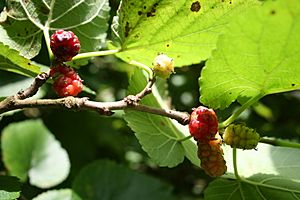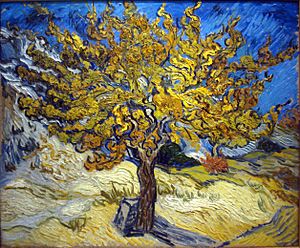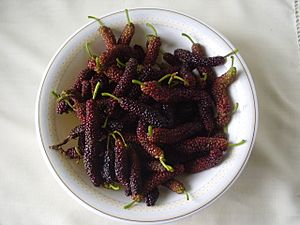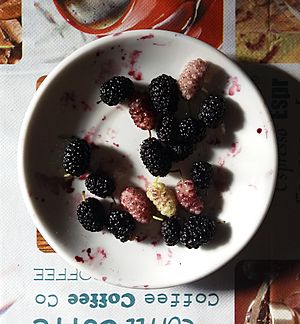Morus (plant) facts for kids
Quick facts for kids Mulberry |
|
|---|---|
 |
|
| Morus nigra | |
| Scientific classification |
|
| Kingdom: | Plantae |
| Clade: | Tracheophytes |
| Clade: | Angiosperms |
| Clade: | Eudicots |
| Clade: | Rosids |
| Order: | Rosales |
| Family: | Moraceae |
| Tribe: | Moreae |
| Genus: | Morus L. |
| Species | |
|
See text. |
|
Mulberries are a group of flowering plants known as Morus. They are deciduous trees, meaning they lose their leaves each year. You can find mulberries growing wild or farmed in many parts of the world, especially in places with mild weather.
There are three main types of mulberry trees, often named after the color of their fruit: white, red, and black mulberry. Their scientific names are Morus alba, Morus rubra, and Morus nigra. Even though the "white mulberry" is named for its white fruit, wild white mulberries actually have black fruit, just like other mulberries. The white mulberry first came from South Asia. Today, it grows in Europe, Southern Africa, South America, and North America. In some places like Brazil and the United States, it is considered an invasive species. This means it can spread easily and take over areas where native plants used to grow.
A plant called the paper mulberry (Broussonetia papyrifera) is also sometimes called a mulberry, but it belongs to a different, though related, group of plants.
Contents
What Do Mulberries Look Like?
Mulberry trees grow quickly when they are young. They can reach up to 24 meters (about 79 feet) tall. Their leaves are arranged one after another along the stem. They are usually simple, often with wavy edges or lobes. Younger branches tend to have more lobed leaves than older parts of the tree.
The mulberry fruit is not a single berry but a cluster of many small fruits joined together. It is usually about 2 to 3 centimeters (about 1 inch) long. When mulberries are young, they are white, green, or light yellow. As they ripen, they turn pink, then red, and finally dark purple or black. Fully ripe mulberries are sweet and delicious!
Types of Mulberry Species
Scientists find it tricky to classify all the different types of Morus trees. Over 150 names have been given to mulberry species, but only about 10 to 16 are widely accepted by most plant experts. It's even more complicated because different mulberry species can easily crossbreed with each other. This means they can create new types of mulberries that can also have their own offspring.
Here are some of the accepted mulberry species:
- Morus alba – White mulberry (from China, Korea, Japan)
- Morus australis – Chinese mulberry (from China, Japan, Indian Subcontinent, Myanmar)
- Morus cathayana – From China, Japan, Korea
- Morus indica – From India, Southeast Asia
- Morus insignis – From Central America and South America
- Morus japonica – From Japan
- Morus macroura – Long mulberry (from Tibet, Himalayas)
- Morus mesozygia – African mulberry (from south and central Africa)
- Morus mongolica – From China, Mongolia, Korea, Japan
- Morus nigra – Black mulberry (from Iran, Caucasus)
- Morus rubra – Red mulberry (from eastern North America)
- Morus serrata – From Tibet, Nepal, northwestern India
Where Mulberries Grow and How They Are Farmed

Black, red, and white mulberries are common in Southern Europe, the Middle East, northern Africa, and the Indian subcontinent. People in these areas often make Jams and sweet drinks called sherbets from the fruit.
Black mulberries were brought to Britain in the 1600s. People hoped they would be useful for raising silkworms. Mulberries were also used in folk medicine, especially to treat skin problems like ringworm. In Greece, especially in a region called the Peloponnese, mulberries are very common. This region was even known as Morea in the Middle Ages, which comes from the Greek word for mulberry tree.
You can grow mulberries from seeds, but it can take up to ten years for these trees to produce fruit. Often, people plant mulberries using large cuttings from existing trees, which grow roots easily.
Mulberry trees are usually pruned once a year during the monsoon season. This helps them grow with a good shape and produce many leaves. The leaves are picked several times a year, especially in areas that rely on rain. Branches that are cut off in the fall are used to make strong baskets for farming and raising animals.
Some cities in North America have banned planting male mulberry trees. This is because male trees produce a lot of pollen, which can cause pollen allergies and even asthma for some people. Female mulberry trees, however, produce flowers that actually help clean the air by attracting pollen and dust. Because of this, female mulberry trees are considered very low-allergy plants.
You can also attach parts of one mulberry tree (called a scion) onto another mulberry tree. This is called grafting. It's often done in winter when the tree is resting. For example, a male mulberry tree that causes allergies can be changed into an allergy-free female tree by grafting female branches onto it.
Mulberry Nutrition
| Nutritional value per 100 g (3.5 oz) | |
|---|---|
| Energy | 180 kJ (43 kcal) |
|
9.8
|
|
| Sugars | 8.1 |
| Dietary fiber | 1.7 |
|
0.39
|
|
|
Protein
|
1.44
|
| Vitamins | Quantity
%DV†
|
| Vitamin A equiv. |
0%
1 μg |
| Thiamine (B1) |
3%
0.029 mg |
| Riboflavin (B2) |
8%
0.101 mg |
| Niacin (B3) |
4%
0.62 mg |
| Vitamin B6 |
4%
0.05 mg |
| Folate (B9) |
2%
6 μg |
| Vitamin C |
44%
36.4 mg |
| Vitamin E |
6%
0.87 mg |
| Vitamin K |
7%
7.8 μg |
| Minerals | Quantity
%DV†
|
| Calcium |
4%
39 mg |
| Iron |
14%
1.85 mg |
| Magnesium |
5%
18 mg |
| Phosphorus |
5%
38 mg |
| Potassium |
6%
194 mg |
| Sodium |
1%
10 mg |
| Zinc |
1%
0.12 mg |
| Other constituents | Quantity |
| Water | 87.68 g |
|
Link to United States Department of Agriculture Database entry
|
|
| †Percentages estimated using US recommendations for adults. | |
Raw mulberries are mostly water (88%). They also contain about 10% carbohydrates, 1% protein, and a small amount of fat. A 100-gram serving of raw mulberries has about 43 calories. It provides a good amount of vitamin C (44% of what you need daily) and some iron (14% of daily needs). Other important nutrients are present in smaller amounts.
What Are Mulberries Used For?
Eating Mulberries
As mulberries ripen, they become soft, plump, and juicy, much like a blackberry. The color of the fruit can vary, even within the same species. Mulberries can be white, lavender, or black. White mulberries are usually sweet but not tart. Red mulberries are often deep red, sweet, and juicy. Black mulberries are large and juicy, with a good balance of sweetness and tartness.
The white mulberry, which is common in cities in eastern North America, has a unique flavor. It's often described as refreshing and a little tart, with a slightly gummy texture and a hint of vanilla. In North America, the white mulberry is considered an invasive plant. It has spread widely and taken over areas where native plants, like the red mulberry, used to grow.
People use mulberries in many ways, such as in pies, tarts, wines, sweet drinks called cordials, and herbal teas. The black mulberry (from southwest Asia) and the red mulberry (from eastern North America) have strong, distinct flavors.
The fruit and leaves of mulberries are also sold as dietary supplements. However, it's important to know that unripe mulberries and green parts of the plant have a white sap that might be harmful.
Mulberries and the Silk Industry

Mulberry leaves, especially those from the white mulberry, are super important for silkworms. Silkworms (whose scientific name is Bombyx mori, named after the mulberry genus Morus) eat only mulberry leaves. The cocoon they spin is used to make silk. Even wild silk moths eat mulberry leaves. Other insect larvae, like the common emerald moth and the fall webworm, also enjoy eating mulberry plants.
Ancient Greeks and Romans grew mulberries to feed silkworms. People have been wearing silk for a very long time. For example, a Roman emperor wore a silk robe as early as 220 AD. Silk and mulberry trees were also important in the early days of colonial Virginia.
Mulberry Pigments and Dyes
The beautiful colors of mulberry fruits come from natural substances called anthocyanins. These are the same things that give other fruits and plants their orange, red, purple, black, and blue colors. Anthocyanins dissolve in water and can be easily taken out of the fruit. This makes them great for use as natural food colorants. Because more and more people want natural food colors, anthocyanins from mulberries are used in many food products.
Scientists have found an easy way to get anthocyanins from mulberry fruit. These can be used as a dye for fabric or as a food color. After the anthocyanins are removed, the remaining juice still has its sugars, acids, and vitamins. This means the juice can still be used to make other food products.
Mulberry plants can be used to find new types of fruit-producing mulberries. Scientists study these plants to find out how much anthocyanin they contain. They also work to create new mulberry varieties with even more anthocyanins.
Mulberry Paper
During the time of the Khmer Empire in Southeast Asia, Buddhist monks used the bark of mulberry trees to make paper. This special paper was used to create books called kraing.
Today, the thinnest paper in the world, called Tengujo, is made in Japan. It is also made from the stems of mulberry trees.
Mulberries in Culture

The popular nursery rhyme "Here We Go Round the Mulberry Bush" features the mulberry tree in its song. Some versions of the nursery rhyme "Pop Goes the Weasel" also mention the mulberry tree.
The famous painter Vincent van Gogh included the mulberry tree in some of his paintings. One well-known painting is Mulberry Tree (1889), which is now in the Norton Simon Museum in Pasadena, California. He painted it after staying in a mental hospital, and he thought it was a very successful painting.
Images for kids
-
A mulberry tree in England
See also
 In Spanish: Morus (planta) para niños
In Spanish: Morus (planta) para niños












